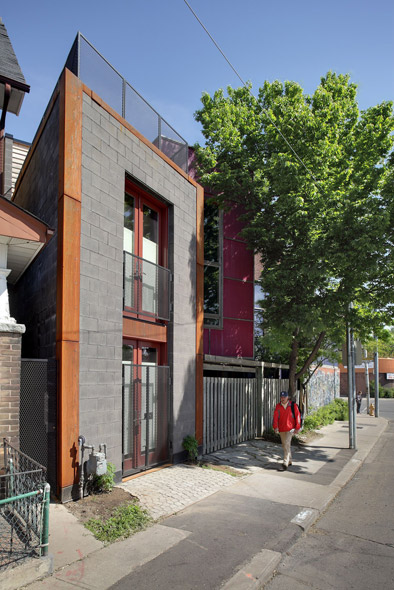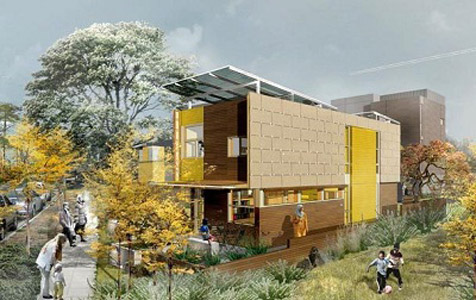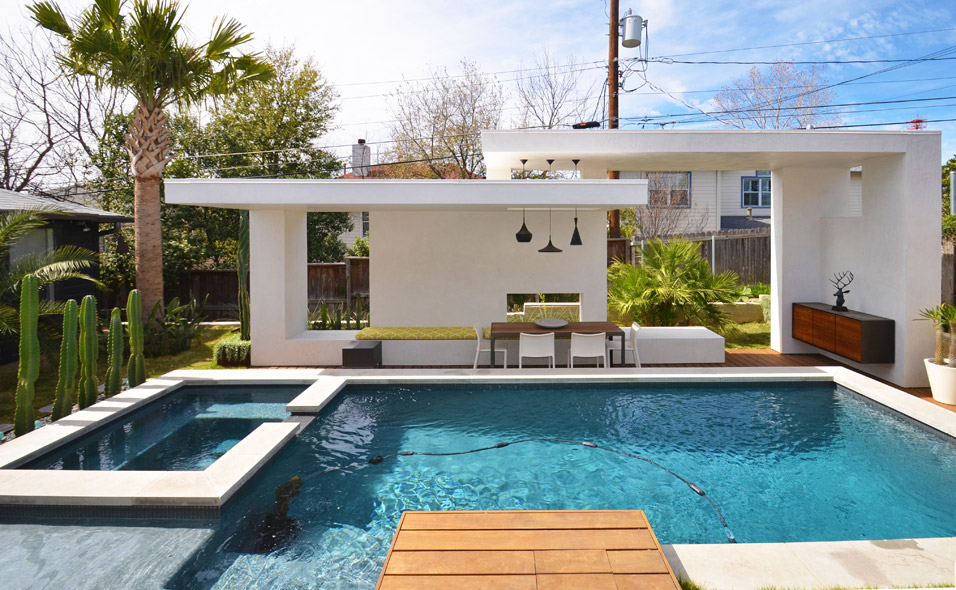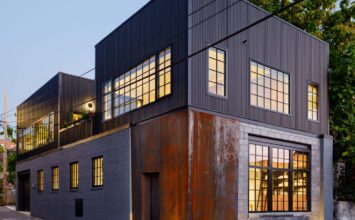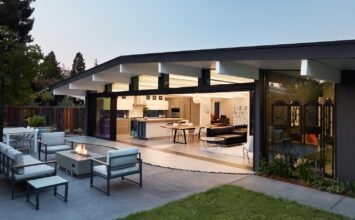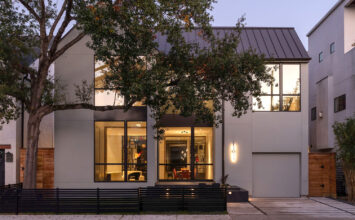
1294 College Street | Toronto | M6H 1C6
Architecture by: Spaces By Rohan Inc.
Photography by: Peter Legris
Built 2012, 2 bedroom, 2 bath, 1084 Square Feet
Lot area 473 (12ft x 39.5ft) square feet and former driveway for two cars.
Rohan Walters also known as Spaces By Rohan Inc. has managed to buy this scrap of land in the middle of downtown Toronto on a lay-a-way plan for work he had done for a developer. $12,600. He was grateful. Rohan lives low on the hog in Hog Town (a.k.a. Toronto), modestly and carefully. Nevertheless, Rohan continues to be grateful for scraps of land he encounters. Those scrap parcels, actual and metaphoric, from the larger table in order to make delicious habitable spaces from the leftovers of others.
Basic Attributes of the Driveway House:
• Simple and dignified – Black Concrete Blocks = Sturdy and Utilitarian with an inherent grace and strength. Further concrete blocks add to the ‘thermal mass or heat sink’ of the building. In other words it is slow to react to temperature changes and therefore moderates the walls thermal performance.
• Inside the outer layer of walls are two 3 types of insulation. Foil face on one inch of polystyrene, then another foil face, then 3 ½ inches of super high density spray foam insulation, ¾ inch douglas fir plywood (for wall anchoring of chair lifts, grab bars, painting etc.), 5/8 inch fire resistant drywall. In summary the foil layers although are not officially counted in the building code they contribute in actual performance of reflecting radiant heat. When combined with an approximate thermal wall rating of R-30 the affect is astounding from a heat-loss and heat gain perspective.
• The ground floor is an 8 inch thick black colored reinforced concrete slab with hot water radiant tubes every 6 inches. Beneath the slab is a vapor barrier; another foil faced ridged insulation (R10 by code, foil face gives much higher performance as it reflects radiant heat back into interior space whilst the ridged foam reduces conductive heat transfer). Further the fact that this small site has no basement was a conscious choice and therefore an additional benefit is the reduction of the passive movement of ground water reduces the transfer of heat from the slab. In other words, dry ground/slab has higher thermal performance than wet or damp ground/slab.
• The 2nd and 3rd floors are 1 ½ inches of light weight concrete housing hot water radiant tubes as well with a finished cork floor. In principle, all three concrete based floors act as a heat sink or thermal mass. In the winter, they are heated by the hot water and once up to a temperature of 80º F or so they hold their heat for a very long time over the course of day. Some winter days when the sun is shining or there have been a few guests present, the heat will not go on at all.
• In the summer the concrete floors reverse their thermal action. The house is designed to draw cool air from the lower garden through the house at the 3rd floor at night. This acts to cool the 2nd and 3rd floors in particular. The ground floor, because it is 8-inch thick concrete, will be a few degrees above native soil temperatures, approximately 70º F or so. Essentially then, if summer air temperatures average between 75º F and 82º F what these floors essentially do is to draw the heat ‘out’ of the air in the room and away from your body through your feet, thereby not only cooling the room air but cooling the body as well. A principle in energy movement is that energy moves from a higher state of vibration to a lower state of vibration. In other words things that are warm will move to things that are cooler.
• Radiant floor heating preserves the airs natural humidity by not burning the air as forced air systems do. Therefore the ‘natural’ humidity of the air reduces the amount of moisture being extracted from our bodies in the wintertime environment and is a healthier for our lungs and skin in comparison to forced air systems that essential burn the air while heating it and remove near all moister in the process. Radiant floors ‘warm’ the air.
• Radiant floors by virtue of warming your feet and warming from the ground up allow us to keep the thermostat at a lower air temperature than forced are or hot water rad systems. The floor temperatures in winter will be between 76º F and 82º F. Therefore when your feet are warm your body is warm. In addition, the heat is evenly distributed: There are little or no cold spots.
• Keeping the wood joists exposed is a passive means of moisture control. Wood itself is a natural desiccant. So is concrete for that matter. Therefore by having he carpenters be a little more careful in the placement and treatment of the wood, the utilitarian nature of the structure takes on a simple but dignified expression as well.
• With regard to light and volume: Key to the success of this place is the bringing in of light to right to the back of the house. The rolling-glass bathroom doors are frosted for privacy while simultaneously letting light from the adjoining front rooms cascade in all through the day. Furthermore the 2nd and 3rd bedroom spaces have their interior walls of glass as well. The 2nd floor is clear tempered glass with curtain whilst he 3rd is frosted tempered.
• The roof-top cedar deck/patio protects most of the roof membrane from ultra-violet light and heat-gain. The roof composition is comprised of polyisocyanurate insulation and sloped insulation board giving it a thermal rating of approximately R-34 to R-36.
• The ground floor is designed to be barrier-free (a.k.a. wheelchair and walker friendly) if required. Even the condensing washer/dryer combination unit is front loadable. This condensing washer/dryer unit does not use interior air to be heated in order to dry the clothes. It is ‘ventless’ and is simply connected to existing drain systems therefore reducing it’s energy requirement to 15-amp vs. the normal 30-amp draw. The unit works beautifully and saves electricity and water.
• The water line coming into the house is placed within and insulated trench below the slab. That trench also facilitates the sewer pipes. The advantage of the sewer pipe being located in this insulated trench means the water pipe did not have to be electrical heating wire as is normally required by building code in cold climates. The reason for this is the temperature of the gases in the sewer pipe never falls below freezing. Recall the steam coming from our sewer grates on -20º days in our cities. Those grates are in fact steam vents. Warm and hot water vents. The Driveway House takes advantage of this free heat to keep the incoming water pipe safe from freezing by keeping it warm in an insulation jacket. This is great because even if the electric power goes out the water intake is safe from freezing.
• The on-demand gas fired domestic hot water and space heating unit is extremely efficient.
• 95% of the lighting is LED based.
• There is a heat recovery ventilator installed and is required by building code. The occupant as required controls this piece of machinery.
• In 2013, in Toronto, Ontario, Canada, with two adults living in this approximately 1100 square foot house the average monthly cost for utilities which include: electricity, water/sewer, gas and sales tax is $100/month and a few cents.



